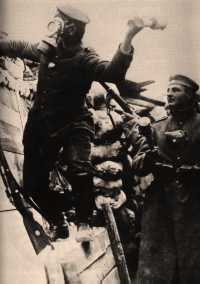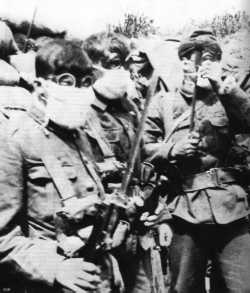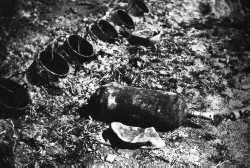The Second Battle of Ypres, Apr-1915
 |
| Gas was often a double-edged sword capable of blowing back to its point of origin. A German tosses grenades wearing a gas mask. |
Contributed by Dave Love
|
Dave has been a member of Calgary Military Historical Society for 15 years. His area of specialization is the Canadian Chaplains Corps. Comments/questions for Dave can be routed through The Calgary Military Historical Society. This article originally appeared in the May 1996 issue of Sabretasche (Vol 26, No 4).
|
The Second Battle of Ypres, Apr-1915by Dave LoveDeclaration of war by Canada in September 1914 led to the immediate raising of a first Canadian contingent consisting of the 1st Canadian Division. After a short three to four weeks training at Camp Valcartier in Quebec, they embarked to the United Kingdom and another several months of basic training. The majority of this training consisted of conditioning and basic military skills such as shooting - little instruction in trench warfare was done. After several months of this, the Canadians were considered ready to assume active operations. Upon their landing in Flanders, the 1st Canadian Division was assigned a sector in front of the Belgium city of Ypres, a place where the Allied line had pushed a bulge-like incursion into German-held territory - the Ypres Salient. Arriving on April 17, 1915 and lacking, as mentioned, any first-hand trench experience, the Canadians immediately moved into the front lines. While this sector had seen the severest fighting of the war the previous autumn, it was quiet on the Canadiansí arrival. Little did they realize, though, that within five days they would be involved in what turned out to be the greatest defensive battle ever fought by Canadian troops - the Second Battle of Ypres.
While the Canadian division was under the command of General Alderson, a British professional soldier, and while the staff included several highly-trained British staff officers, command at the Brigade level and lower was practically all in the hands of Canadians - lawyers, businessmen, real estate agents, newspaper men, etc., whose only military experience was as part-time officers of the Canadian Militia. The men themselves were, if anything, even more inexperienced than their officers. Yet these amateur soldiers were to face an army whose officers and men were highly-trained professionals and who considered themselves invincible. The situation on the eve of battle was that the Canadians had only just been moved up into the front lines and had not become fully oriented to their surroundings. The French army, consisting of the 87th Territorial and 45th Algerian Divisions (colonial Moroccan and Algerian troops), was on their immediate left flank while the line to their right was held by the British. Across No-Manís-Land, the Germans had achieved a local superiority of seven and a half divisions to the Allied forcesí six and were far stronger in artillery support. The Germans attacked on the evening of 22 April, 1915. Despite the Hague Convention which outlawed chemical warfare (and two unsuccessful experiments with gas shells), the Germans decided to release 5700 cylinders of chlorine - this to be accompanied by heavy artillery bombardment and followed by strong infantry assaults. The gas was released from these cylinders just in front of the German lines or through potholes punched through trench parapets. As a weapon, gas was particularly advantageous when used against soldiers in defensive positions. Being heavier than air, chlorine followed the groundís contours and sank into the trenches and shell holes soldiers used as protection against shrapnel and bullet. This forced them to abandon their defences in favour of higher ground. Those who did stay found it extremely difficult to fight with watery eyes, heaving stomachs and burning lungs. It could thus be more effective than artillery, which had to be very accurate to do any damage to a defensive position, or rifle fire, which required the enemy to expose himself. The story of the gas attack has often been told - of an olive-green cloud rolling over Algerian positions on the left of the 1st Canadian Division, of many men dead or dying of suffocation and others running blindly to the rear. While the Canadians were not the direct target for gas attack on that first day of the battle, many were witnesses to the initial German assaults and many felt its residual effects. The 10th Canadian Infantry Battalionís war diary reported the experiences of some of its officers: "Maj. McLaren, Maj. Ormond and Capt. Glidden [the Medical Officer] riding between Elverdinge and Brielen hear bombardment from the northeast and see shells breaking, also cloud of peculiar colour (greyish, yellowish, greenish), darker near the ground and lighter in colour near top." One Canadian officer, looking towards the French lines and seeing the greenish yellow mist, thought the infantry there were firing with a different kind of powder. Such short and confused reports announced the introduction of chemical warfare to the Western Front. The French colonials, whose soldiers received full doses of the vapour, gave way before the gas attack, leaving a breach in the Allied lines of over four miles wide, which the Germans were quick to exploit. The Canadians were asked to try and seal off the gap and hold the line which now was coming under attack not only from additional gas and artillery, but also direct assaults by German infantry. In this the Canadians were largely successful. In particular, that first night, the 10th and 16th Canadian Infantry Battalions were ordered to recapture Kitchenerís Wood, a large copse of trees in which the Germans had set up new defences. Their attack was a typical example of the tactics of the day. The men formed up in a nearby field under cover of darkness to avoid the German shelling. When the time came to attack, the 1500 troops stood up in eight ranks at intervals of about thirty yards. There was just enough light for these soldiers to see the woods they were to capture, 500-600 yards away. A house off to one side, suspected (accurately) of harbouring machine-guns, they left alone, because officers determined, to their grief, it was not their job to take it. At 11:45 the attack began. At this point the two battalions were on their own, since they had no way to communicate with headquarters or supporting artillery, except through runners. Artillery support having ceased, the Canadians had to rely on their rifles, bayonets and bombs to carry out the assault, which took place just three minutes after setting out. There was a momentary pause at an unexpected hedge which brought down a hail of bullets, due to the noise of breaking through. Those unhit burst through the hedge at a fast run and struck the foremost enemy trench, where work with bayonet and butt soon cleared the position. The whole body then swept forward and, after heavy and close fighting, cleared the wood. In spite of heavy German rifle and machine-gun fire and the absence of Canadian artillery support, the assault was a success. Casualties were high however and holding the newly-won line was to be more difficult than taking it had been. The Germans, as was common in 1915, organized their defences in depth, even if they had just recently captured the ground they were defending. The Canadians, as it turned out, had managed to cave in the first line, but there were others from which the German commanders could launch their men into counterattacks. Ultimately under a series of strong counterattacks and rising casualties, the two battalions had to retire. Other similar Canadian counterattacks throughout the night and in brigade strength at least twice in daylight the next day were carried out. Casualties were very heavy and little ground was gained, but these further delayed German attempts at exploitation and gave other reinforcing troops - Canadian, British and French - sufficient time to close most of the gap. The result is that throughout the 23rd, the Canadians still held their positions more or less. As mentioned some retreat had occurred in order to consolidate forces, but the line was held.
On April 24 , the enemy struck again. A great bombardment and another cloud of gas repeated the pattern of the first attack. This time a light breeze carried gas onto the Canadian positions, resulting in the full effects of the vapour settling upon the troops. The Canadians, without protection other than wet cloths over their faces, could do little but withdraw. Evacuating the first line of trenches, the men moved back a bit to lie on their stomachs and wait. Meanwhile, Canadian artillery, firing shrapnel over open sights, kept the Germans from taking the Canadian positions, until reoccupied once the gas dissipated. The gas, which had come as a complete surprise to the Algerians, now began to lose some of its novelty. It was found the wet and soil-impregnated cloths tended to absorb most of the vapour and allowed the troops to function to some extent. The result was that relatively few were totally overcome (the 1st Division lost only 228 men injured by gas however many had lasting effects of varying degrees that would plague them the rest of their lives). Many casualties, though, were probably caused due to a gas-induced diminished capacity to defend themselves. Most found breathing to be very difficult and it was hard to resist the temptation to tear away the damp cloths and gulp air, but the worst effects lasted only a few minutes. Also because the fumes made it difficult or impossible for German observers to call the fall of shot, the German infantry was forced to advance without artillery support. The Canadians waited until they came upon their empty trenches and then opened fire from ranges less than 100 yards. As a result they were able to beat off most of the repeated attacks, and caused heavy German casualties. Notwithstanding this general state of affairs, there were set backs. From the northern fringe of St. Julien, the 15th Battalion (3rd Brigade) was forced back with enormous losses to a line south of the village. To the right, on the forward slope of Gravenstafel Ridge, the 8th Battalion (2nd Brigade) stood firm. However, Brigadier A.W. Currie, commanding the 2nd Brigade, managed to fill the former gap at St. Julien with fresh troops and fresh British troops supported on the right. So even under the horrible surprise of gas the Canadians in their first major battle held the line against many times their numbers. The Canadians were withdrawn from the battle on May 3, being relieved by the British. Losses had been heavy. Of a maximum divisional strength of 18,000 that had started the battle, 5975 had become casualties, of whom over 1000 were fatal. Most of these casualties were infantrymen. The fighting of the first few days, as the Canadians counterattacked to recapture lost ground, had been heavy, but the worst day for the division was April 24, when it had to defend its own trenches against determined attacks by gas, shelling and infantry. 3058 of the casualties occurred on this day alone. What of the aftermath of the battle? Firstly, the Germans did not follow up their advantage. The attack was essentially a testing ground for the new weapon and not a major offensive. As a result, the Germans, dubious of any major success, had failed to provide sufficient reserves with which to exploit the initial resulting gap. Had the Germans broken through to Ypres and continued southward along the Yser Canal, they would have cut off 50,000 British and Canadian troops and removed the salient. But through the determined defence of the Canadians, they could not carry through with the forces at hand. On the Canadian side.... The Canadians to a man seemed obsessed with the idea that this was their particular battle and that they would perish where they stood rather than give way. The nationalistic policy of keeping the Canadians together as a unit received strong reinforcement from this battle. The "colonials" had made good and were fitted to take their place, as a separate entity, by the side of the finest British and French fighting divisions. Everywhere throughout France and Belgium the word "Canada" was greeted with enthusiasm and the work of the division was appreciated to its fullest value. Lastly, deficiencies of Canadian equipment became clear once and for all. The Ross Rifle and its tendency to jam under rapid fire did not stand the test well. The Oliver webbing then in use, proved inadequate, as did other items of kit. From this point onward, the Canadians began to be outfitted with proven British patterns and weapons. Second Ypres proved to be the worst battle the 1st Canadian Division
would fight in the course of the war, however its result was the starting
point of the strong reputation Canadian troops developed during the war.
A word on poison gases used in the First World War.
Basically the three main types used were - chlorine, phosgene and mustard gas. Chlorine - a greenish, yellow heavier than air gas which in its pure form is an oxidizing agent. This means that it will react in the presence of water to cause a chemical burning effect on organic matter. Mucus tissues of the human body are susceptible to such chemical reaction because of 1) their organic nature and , 2) they are always covered with a film of water. Symptoms of chlorine gas poisoning include vomiting, difficulty in breathing, a burning sensation in the lungs, eyes, nasal and mouth passages, watery eyes. In severe cases, cell damage in the lungs leads to fluid buildup in the lungs, loss of consciousness through suffocation, and death. Phosgene - a colourless, odorless, heavier than air gas formed by heating carbon tetrachloride. It is highly poisonous in that it will preferentially replace oxygen in the cells and quickly causes an oxygen debt within the body, unconsciousness and death. Mustard gas - a caustic gas with a distinctive mustard smell, it causes
blistering and huge sores on any exposed tissue, internal or external.
Probably the most used gas, with phosgene, in the war. A nasty piece of
business.
References:Aitken, M.(1916) Canada in Flanders - The Official History of the Canadian Expeditionary Force Vol. 1, Hodder and Stoughton, Toronto Dancocks, D. (1988) Welcome to Flanders Fields, The First Canadian Battle of the Great War: Ypres, 1915. McCelland and Stewart Publishing, Toronto Dancocks, D.(1994) GALLANT CANADIANS - The Story of the Tenth Canadian Infantry Battalion. The Calgary Highlanders Regimental Funds Foundation, Calgary, Alberta Haythornthwaite, P.J., (1994) The World War One Source Book, Arms and Armour Press, London McWilliams, J., and Steel, R.J.,(1985) GAS ! THE BATTLE FOR YPRES, 1915, Vanwell Publishing, St. Catharines, Ontario. |



